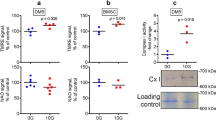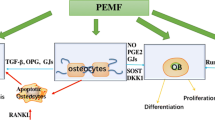Abstract
Electromagnetic fields are known to affect the bone metabolism by modifying some relevant physiologic cell parameters of cells, even though the underlying mechanisms are still unclear. The aim of our study was to evaluate the effect of both static magnetic fields (SMFs) of the same intensity of the one generated by spinal metal devices and pulsed electromagnetic fields (PEMFs) of the same intensity used for the management of nonunion on human osteoclasts cell culture. Primary osteoclast cells were isolated from primary human osteoclast precursors and were exposed to SMFs and to PEMFs. Morphology and tartrate-resistant acid phosphatase (TRAP) activity were evaluated in the osteoclast cultures after 7, 10, and 14 days of exposure. The SMF-exposed cells show a more differentiated phenotype and a significantly higher TRAP activity after 7 and 10 days of treatment with respect to a sham control. PEMF-exposed cells have a less-differentiated phenotype after 7 days of exposure compared with the relative sham control, while the TRAP activity shows no statistically significant differences between exposed and control cells at any observation time. Our results indicate that SMFs of the same intensity of the one generated around spinal devices can affect osteoclast differentiation and activity. Aseptic loosening around titanium implants might be due in part to an increased osteoclast activity and differentiation. PEMFs of the same intensity than the one used for the management of nonunions can affect osteoclasts phenotype after 7 days of exposure, while osteoclasts TRAP activity is not affected by this kind of electromagnetic fields.





Similar content being viewed by others
References
Jacobs JJ, Hallab NJ, Urban RM, Wimmer MA (2006) Wear particles. J Bone Joint Surg Am 88(Suppl. 2):99–102
Denaro V, Papapietro N, Sgambato A et al (2008) Periprosthetic electrochemical corrosion of titanium and titanium-based alloys as a cause of spinal fusion failure. Spine 33(1):8–13
Denaro V, Cittadini A, Barnaba SA (2008) Static electromagnetic fields generated by corrosion currents inhibit human osteoblast differentiation. Spine 33(9):955–959
Guerkov HH, Lohmann CH, Liu Y, Dean DD, Simon BJ, Heckman JD, Schwartz Z, Boyan BD (2001) Pulsed electromagnetic fields increase growth factor release by nonunion cells. Clin Orthop Relat Res. 384:265–279
Liboff AR, Williams T Jr, Strong DM et al (1984) Time-varying magnetic fields: effect on DNA synthesis. Science 223(4638):818–820
Farndale RW, Murray JC (1985) Pulsed electromagnetic fields promote collagen production in bone marrow fibroblasts via athermal mechanisms. Calcif Tissue Int 37(2):178–182
Lee KE, Pelker RR (1985) Effect of freezing on histologic and biomechanical failure patterns in the rabbit’s capital femoral growth plate. J Orthop Res 3:514–515
Wang W, Wang Z, Zhang G, Clark CC, Brighton CT (2004) Up-regulation of chondrocyte matrix genes and products by electric fields. Clin Orthop Relat Res. 427:S163–S173
Hannay G, Leavesley D, Pearcy M (2005) Timing of pulsed electromagnetic field stimulation does not affect the promotion of bone cell development. Bioelectromagnetics 26(8):670–676
Foley KT, Mroz TE, Arnold PM, Chandler HC Jr, Dixon RA, Girasole GJ, Renkens KL Jr, Riew KD, Sasso RC, Smith RC, Tung H, Wecht DA, Whiting DM (2008) Randomized, prospective, and controlled clinical trial of pulsed electromagnetic field stimulation for cervical fusion. Spine J 8(3):436–442
Chang K, Chang WH, Tsai MT et al (2006) Pulsed electromagnetic fields accelerate apoptotic rate in osteoclasts. Connect Tissue Res 47(4):222–228
Chang K, Chang WH, Wu ML et al (2003) Effects of different intensities of extremely low frequency pulsed electromagnetic fields on formation of osteoclast-like cells. Bioelectromagnetics 24(6):431–439
Chang K, Chang WH, Huang S et al (2005) Pulsed electromagnetic fields stimulation affects osteoclast formation by modulation of osteoprotegerin, RANK ligand and macrophage colony-stimulating factor. J Orthop Res 23(6):1308–1314
Shankar VS, Simon BJ, Bax CM et al (1998) Effects of electromagnetic stimulation on the functional responsiveness of isolated rat osteoclasts. J Cell Physiol 176(3):537–544
Roodman GD (1999) Cell biology of the osteoclast. Exp Hematol 27(8):1229–1241
Kalbacova M, Roessler S, Hempel U, Tsaryk R, Peters K, Scharnweber D, Kirkpatrick JC, Dieter P (2007) The effect of electrochemically simulated titanium cathodic corrosion products on ROS production and metabolic activity of osteoblasts and monocytes/macrophages. Biomaterials 28(22):3263–3272
Punt IM, Cleutjens JP, de Bruin T, Willems PC, Kurtz SM, van Rhijn LW, Schurink GW, van Ooij A (2009) Periprosthetic tissue reactions observed at revision of total intervertebral disc arthroplasty. Biomaterials 30(11):2079–2084
Chambers TJ (1985) The pathobiology of the osteoclast. J Clin Pathol 38:241–252
Hosokawa Y, Sakakura Y, Tanaka L et al (2007) Effects of local and whole body irradiation on appearance of osteoclasts during wound healing of tooth extraction sockets in rats. J Radiat Res 48(4):273–280
Komine M et al (2001) Tumor necrosis factor alfa cooperates with receptor activator of nuclear factor kbeta ligand in generation of osteoclast in stromal cell-depleted rat bone marrow cell culture. Bone 28(5):474–483
Hideyuki O, Rie O, Naohide T et al (2006) Effects of a moderate-intensity static magnetic field onVEGF-A stimulated endothelial capillarytubule formation invitro. Bioelectromagnetics 27:628–640
Yu M, Moreno JL, Stains JP, Keegan AD (2009) Complex regulation of tartrate-resistant acid phosphatase (TRAP) expression by interleukin 4(IL-4): IL-4 indirectly suppresses receptor activator of NF-kappaB ligand (RANKL)-mediated TRAP expression but modestly induces its expression directly. J Biol Chem 284(47):32968–32979
Taylor KF, Inoue N, Rafiee B et al (2006) Effect of pulsed electromagnetic fields on maturation of regenerate bone in a rabbit limb lengthening model. J Orthop Res 24(1):2–10
Bose B (2001) Outcomes after posterolateral lumbar fusion with instrumentation in patients treated with adjunctive pulsed electromagnetic field stimulation. Adv Ther 18:12–20
Mooney V (1990) A randomized double-blind prospective study of the efficacy of pulsed electromagnetic fields for interbody lumbar fusions. Spine 15:708–712
Silver RA (2001) Application of pulsed electromagnetic fields (PEMF) after lumbar interbody or posterolateral spinal fusion surgery in a heterogenous patient population. J Neurol Orthop Med Surg 21:51–62
Sul AR, Park SN, Suh H (2006) Effects of sinusoidal electromagnetic field on structure and function of different kinds of cell lines. Yonsei Med J 47(6):852–861
Selvamurugan N, Kwok S, Vasilov A, Jefcoat SC, Partridge NC (2007) Effects of BMP-2 and pulsed electromagnetic field (PEMF) on rat primary osteoblastic cell proliferation and gene expression. J Orthop Res 25(9):1213–1220
Conflict of interest
The authors declare that they have no conflict of interest.
Author information
Authors and Affiliations
Corresponding author
Rights and permissions
About this article
Cite this article
Barnaba, S.A., Ruzzini, L., Di Martino, A. et al. Clinical significance of different effects of static and pulsed electromagnetic fields on human osteoclast cultures. Rheumatol Int 32, 1025–1031 (2012). https://doi.org/10.1007/s00296-010-1724-7
Received:
Accepted:
Published:
Issue Date:
DOI: https://doi.org/10.1007/s00296-010-1724-7




